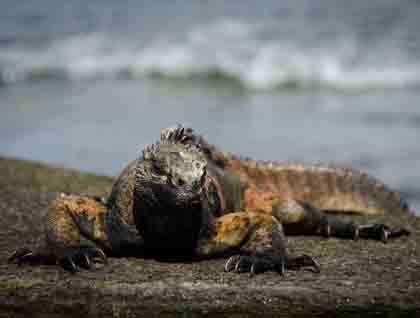This morning National Geographic Endeavour anchored off Espumilla Beach. Our plan was to explore several sites on the west coast of James Island including the island’s main volcano. As the wind swung around from the more common southeasterly trade wind to a light breeze from the north overnight, we expected precipitation during our morning hike.
After returning to the ship after our morning hike and enjoying a well-earned breakfast, we set sail for Buccaneers Cove only a couple of miles north. A natural showcase for the island’s volcanic landscape, this bay was an ideal stopover for ships during the Age of Sail. It’s not hard to imagine captains grounding their ships here during a low spring tide to do maintenance work on the hull. As our guests explored the area by snorkeling, kayaking or riding our glass-bottom boat, we finished off our morning with stories of great abundance of colorful fish and even a few white-tipped reef shark sightings.
Sailing south a few miles across a massive “historical” lava flow (meaning that it happened so recently that it could have been witnessed by humans), we reached Puerto Egas, our stop for the afternoon. After landing on the black-sand beach by Zodiac, we were greeted by Galapagos sea lions and marine iguanas. Taking advantage of the tide that had just started to come back in, Sally Lightfoot crabs fed on tuff lava plateaus seemingly indifferent to our presence.
As we headed back from our afternoon hike along the trail next to the remnants of a failed settlement, the wind picked up from the north, which made for a somewhat splashy return ride to the ship. But at least, thanks to this breeze, there was no afternoon rain.







